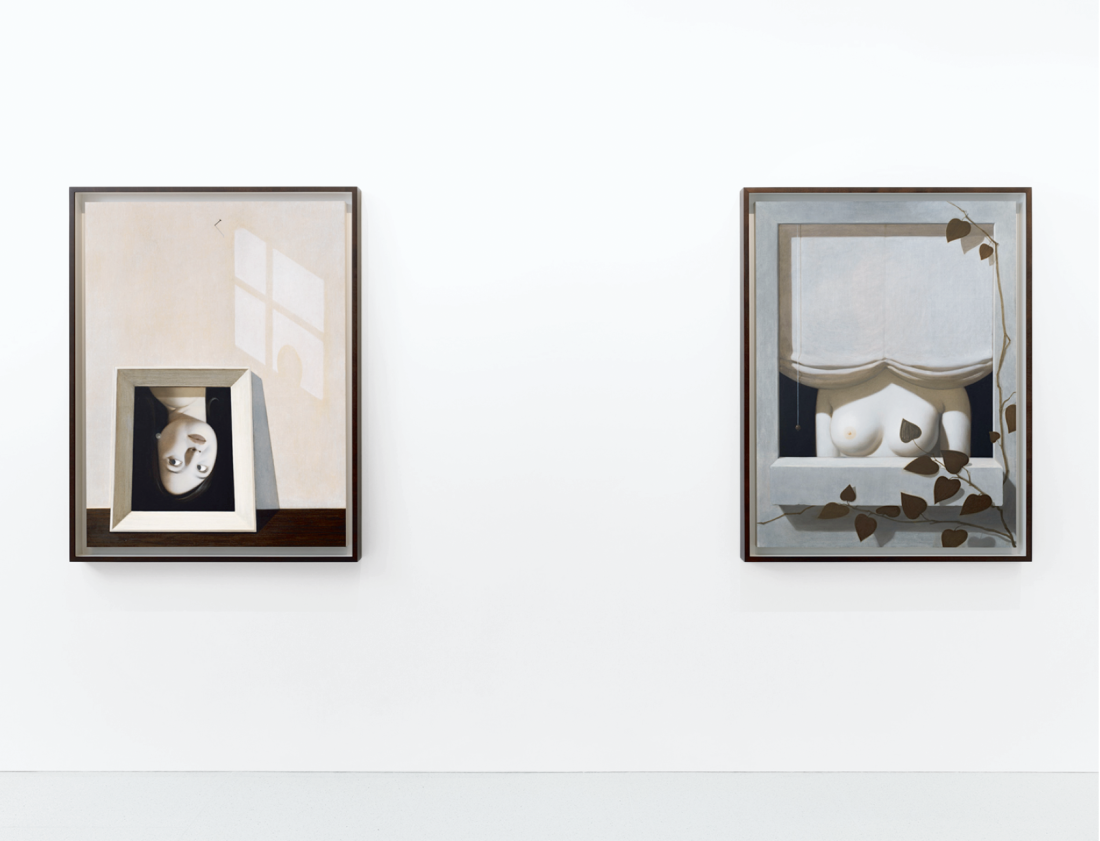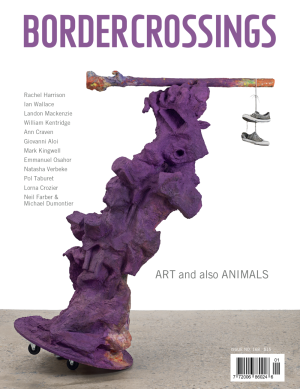Anna Weyant
In Mayfair, the most expensive London property on the Monopoly board, I come across a “woman of a certain age” looking fatigued and jaded. With an aristocratic upturned nose, she leans across a stack of gift-wrapped boxes in an attitude of poised ennui; but she is not so exhausted that she can resist lightly tugging the ribbon on one of these parcels. Unboxing, 2024, is a cartoon scene that finds itself on canvas. This lady, a fiction, has sprung from the imagination of Anna Weyant.
Weyant is a Canadian painter who has been called the art world’s “It Girl”: she is young, and yet this is her third solo show with one of the world’s most high-profile mega galleries. The cartoon aesthetic is just one of her painting modes. The rest of the show consists of icily pale studies of more rounded female subjects who elude the gaze and offer art historical echoes of the sort that will invariably please collectors.

Anna Weyant, installation view, “Who’s Afraid of the Big Bad Wolves?,” 2024, Gagosian, London. Photo: Prudence Cuming Associates Ltd. © Anna Weyant. Courtesy Gagosian, London. Left to right: Here, My Dear, 2024, oil on canvas, 121.9 × 91.4 centimetres; Girl in Window, 2024, oil on canvas, 121.9 × 91.4 centimetres.
It seemed immediately apparent that Weyant is bringing up the moods and motifs of Vermeer and Magritte, along with the haunting and enigmatic nude figures that characterize Paul Delvaux. She assumes both his strangeness and his disturbing eroticism, and her three-dimensional women are rendered with a stillness that reminds one of all three artists from the lowlands. As in Vermeer’s works, we intrude upon the privacy of these characters. A woman with golden hair, Geraldine, 2024, is static behind a bunch of peonies. Another reads a broadsheet newspaper, yet, like the mysterious contents of a Vermeer letter, all text is missing in It’s Coming from inside the House, 2024. A third woman bares her breasts but not her face in Girl in Window, 2024, where a vine tendril protects her modesty. In That’s All Folks, 2024, a fourth, much younger woman is largely in darkness, with torso out of frame; blood on her legs indicates that this anonymous figure is menstruating.
Frames conceal identities, and various windows and reflections bring us back to Magritte. There is a framed painting-within-the-painting, in which the portrait of another young woman becomes the mise en abyme subject of a further work in Here, My Dear, 2024. Her portrait is propped at the foot of the composition, wrong way up, but a trompe l’oeil nail indicates where it might once have hung. In shadow overhead, we see a reflection from a lattice window through which a silhouette is gazing and about whom we can say nothing. These details build to a complex show in which one can only say for sure that Weyant is a master of many painting techniques and conventions. Her menstruating female figure has virtuoso knees: a dramatic effect rendered with chiaroscuro. The golden hair of the girl hiding coyly behind a vase is almost photorealistic. The penchant for reflected onlookers also manifests in the polished sheen of a bowl placed next to the female newspaper reader. When earrings are visible, they, too, are pearlescent, surely a nod to Vermeer’s most iconic portrait.
Despite all this bravura, we come back at the end of this too-brief show to that cartoon with the stack of gifts. Weyant can dumb it down when she chooses to, and the fact is that this flat, illustrative and exhausted-looking woman bookends the show with another piece, Encore, 2024, which is one part cartoon, one part typographic. The cartoon treatment is reserved for a comic book capture of a bunch of daisies. The typography, which is all blocky caps, simply says “ENCORE.” It’s hardly the note I would sound, and Weyant seems aware of this.

Anna Weyant, It’s Coming from inside the House, 2024, oil on canvas, 121.9 × 91.4 centimetres. Photo: Maris Hutchinson. © Anna Weyant. Courtesy Gagosian, London.
By opening with an image of consumer burn-out and closing with an image of ironic overspending, the artist puts her core paintings between snarky parentheses, which undercut the suggestive conceptualism, the technical gifts and the intertextual art historicism of the five main works on display. She is self-deprecating and world-weary in a way that belies her age. As I moved from painting to painting, my attention was caught time and again by goings-on in the street behind me, visible in the glass casings of these works. In a narrow gallery space, with its requisite glass facade, the black cabs seemed to ooze through Weyant’s show, while all of her partial nudes seem to importune the passing glance of well-heeled pedestrians. Could the moneyed individuals who circle in this part of town be the object in the question posed by this show’s title: “Who’s Afraid of the Big Bad Wolves?”
Weyant’s solo debuts in London and Europe in 2023, together with a New York show in 2022, have all been in Gagosian’s blue chip interiors. The painter may also ask herself many questions about this turn of events. What happens when collectors tire? What will she ever do next? Her motifs and technical gifts could sit comfortably in a modern art museum. But at Gagosian, Davies Street, London, in 2024, they are just too close to the nearest Rolls-Royce showroom. I left the gallery with questions. ❚
“Anna Weyant: Who’s Afraid of the Big Bad Wolves?” was exhibited at the Gagosian, London, from October 8, 2024, to December 20, 2024.
Mark Sheerin is a UK-based art writer and cultural historian. He has a PhD in history of art from the University of Sussex and his blog can be found at criticismism.com.

